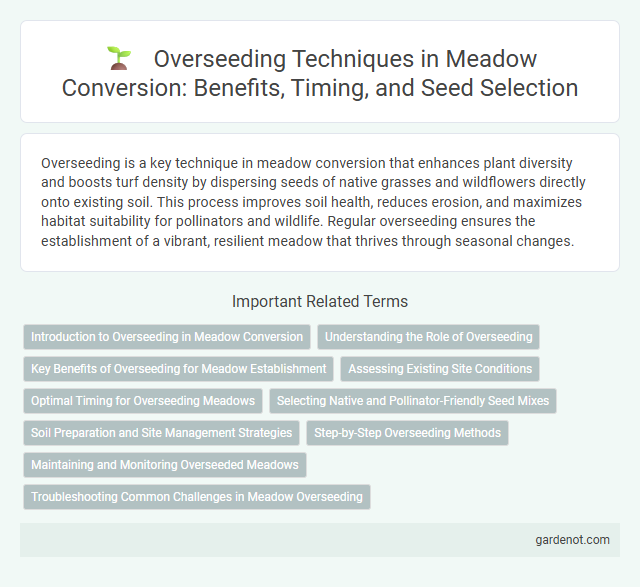Overseeding is a key technique in meadow conversion that enhances plant diversity and boosts turf density by dispersing seeds of native grasses and wildflowers directly onto existing soil. This process improves soil health, reduces erosion, and maximizes habitat suitability for pollinators and wildlife. Regular overseeding ensures the establishment of a vibrant, resilient meadow that thrives through seasonal changes.
Introduction to Overseeding in Meadow Conversion
Overseeding in meadow conversion involves introducing new grass or wildflower seeds into an existing meadow to enhance biodiversity and improve plant density. This technique promotes a diverse species mix, which supports pollinators and benefits soil health by increasing organic matter. Effective overseeding helps establish a resilient meadow ecosystem that adapts to seasonal changes and environmental stresses.
Understanding the Role of Overseeding
Overseeding plays a crucial role in meadow conversion by introducing new grass and wildflower species that enhance biodiversity and improve soil health. This process helps fill gaps in existing vegetation, promotes denser, more resilient plant cover, and accelerates ecosystem restoration. Effective overseeding supports habitat creation for pollinators and wildlife while increasing the meadow's overall ecological value.
Key Benefits of Overseeding for Meadow Establishment
Overseeding enhances meadow establishment by increasing plant density and diversity, which improves soil stabilization and reduces weed invasion. It promotes vibrant, resilient turf that supports pollinators and increases overall ecosystem health. This process also accelerates ground cover formation, leading to faster establishment and prolonged meadow longevity.
Assessing Existing Site Conditions
Assessing existing site conditions is crucial for successful overseeding in meadow conversion projects. Key factors include soil quality, moisture levels, sunlight exposure, and the presence of existing vegetation or invasive species. Detailed site analysis ensures optimal seed selection and improves establishment rates for a thriving meadow ecosystem.
Optimal Timing for Overseeding Meadows
Optimal timing for overseeding meadows is crucial to ensure successful seed germination and establishment. The best periods are typically early spring or late summer to early fall when soil temperatures range between 50degF and 70degF, promoting ideal moisture and climate conditions. Overseeding during these windows enhances seed-soil contact, boosts native species diversity, and improves meadow resilience against weeds and environmental stress.
Selecting Native and Pollinator-Friendly Seed Mixes
Selecting native and pollinator-friendly seed mixes is essential for successful meadow conversion, enhancing local biodiversity and supporting ecosystems. These seed mixes typically include wildflowers such as coneflowers, black-eyed Susans, and asters, which provide nectar and habitat for bees, butterflies, and other pollinators. Using region-specific native seeds ensures adaptability to local soil and climate conditions, promoting sustainable growth and reducing maintenance.
Soil Preparation and Site Management Strategies
Effective soil preparation for overseeding in meadow conversion involves loosening the topsoil to improve seed-to-soil contact and enhance germination rates. Site management strategies should include weed control through mowing or herbicide application, ensuring minimal competition for young seedlings. Maintaining optimal moisture levels during the establishment phase is critical to support seedling growth and achieve a dense, healthy meadow stand.
Step-by-Step Overseeding Methods
Overseeding a meadow requires preparing the soil by mowing existing vegetation and lightly raking to create seed-to-soil contact. Distribute a blend of native wildflower and grass seeds evenly across the area, adhering to recommended seeding rates for optimal germination. Follow with gentle rolling or pressing of seeds into the soil and maintain consistent moisture through regular watering until seedlings are well established.
Maintaining and Monitoring Overseeded Meadows
Maintaining and monitoring overseeded meadows ensures robust plant growth and biodiversity by regularly assessing soil moisture, nutrient levels, and weed presence. Implementing targeted irrigation and timely mowing helps optimize seedling establishment and prevent invasive species from dominating. Consistent observation facilitates early intervention, promoting long-term vitality and resilience of the overseeded meadow ecosystem.
Troubleshooting Common Challenges in Meadow Overseeding
Overseeding a meadow often faces challenges such as poor seed-to-soil contact, uneven seed distribution, and competition from existing vegetation, which can limit germination success. Addressing soil compaction with aeration and ensuring consistent moisture levels improves seedling establishment significantly. Selecting appropriate seed mixtures tailored to local soil and climate conditions reduces issues related to seedling mortality and enhances overall meadow resilience.
Overseeding Infographic

 gardenot.com
gardenot.com